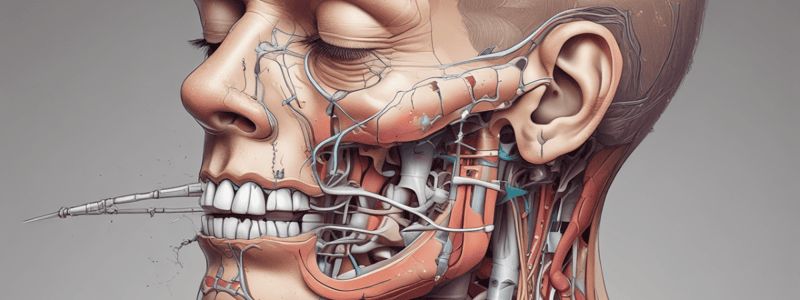Podcast
Questions and Answers
What is the treatment for a patient with a tracheobronchial injury and an unstable airway?
What is the treatment for a patient with a tracheobronchial injury and an unstable airway?
- Surgical repair (correct)
- Lung resection
- Bronchoscopy
- Conservative management
A patient presents with a foreign body in the airway. What is the management of this condition?
A patient presents with a foreign body in the airway. What is the management of this condition?
- Urgent bronchoscopy
- Urgent bronchoscopy with bronchotomy (correct)
- Bronchoscopy with precaution and lung resection
- Surgical repair of the airway
What is the most common site of esophageal injuries?
What is the most common site of esophageal injuries?
- Thoracic esophagus
- Abdominal esophagus
- Lower esophagus
- Cervical esophagus (correct)
What is the investigation of choice for esophageal injuries?
What is the investigation of choice for esophageal injuries?
What is the management of esophageal injuries?
What is the management of esophageal injuries?
What is the common complication of esophageal injuries?
What is the common complication of esophageal injuries?
What is the management of a foreign body in the esophagus?
What is the management of a foreign body in the esophagus?
What is the marker of severe thoracoabdominal trauma?
What is the marker of severe thoracoabdominal trauma?
What is the investigation of choice for diaphragmatic injuries?
What is the investigation of choice for diaphragmatic injuries?
What is the management of cardiac injuries?
What is the management of cardiac injuries?
What percentage of thoracic deaths are attributed to thoracic injury worldwide?
What percentage of thoracic deaths are attributed to thoracic injury worldwide?
What is a characteristic of pediatric thorax in relation to thoracic trauma?
What is a characteristic of pediatric thorax in relation to thoracic trauma?
What type of force is responsible for injuries in acceleration-deceleration injuries?
What type of force is responsible for injuries in acceleration-deceleration injuries?
What is a clinical feature of flail chest?
What is a clinical feature of flail chest?
What is a common associated injury with haemothorax?
What is a common associated injury with haemothorax?
What is the primary goal of initial evaluation in thoracic trauma?
What is the primary goal of initial evaluation in thoracic trauma?
What type of injury is characterized by a tear in the tracheobronchial tree?
What type of injury is characterized by a tear in the tracheobronchial tree?
What is a common complication of sternal fractures?
What is a common complication of sternal fractures?
What is the reported percentage of myocardial contusion in autopsy series of patients with BCI?
What is the reported percentage of myocardial contusion in autopsy series of patients with BCI?
What is the most common site of blunt aortic injuries?
What is the most common site of blunt aortic injuries?
What is the radiographic feature associated with thoracic aortic injury?
What is the radiographic feature associated with thoracic aortic injury?
What is the mortality rate of patients with aortic injuries within 1 week?
What is the mortality rate of patients with aortic injuries within 1 week?
What is the management of blunt aortic injuries?
What is the management of blunt aortic injuries?
What is the most common mechanism of blunt aortic injuries?
What is the most common mechanism of blunt aortic injuries?
What is the clinical presentation of patients with aortic injuries?
What is the clinical presentation of patients with aortic injuries?
What is the treatment of myocardial rupture?
What is the treatment of myocardial rupture?
Flashcards are hidden until you start studying
Study Notes
Tracheobronchial Tree Injuries
- Conservative treatment for tracheobronchial tree injuries
- Surgical approach based on location and extension of injury
- Cervical collar incision for proximal trachea
- Right postero-lateral thoracotomy for lower trachea, carina, right main bronchus (RMB), and proximal left main bronchus (LMB)
- Left postero-lateral thoracotomy for distal LMB
- Management options: primary repair, sleeve resection, lung resection
Foreign Body in the Airway
- Management of foreign body in the airway:
- Acute: urgent bronchoscopy with or without bronchotomy
- Chronic: bronchoscopy with precaution, with or without lung resection
Esophagus Injuries
- Esophagus injuries are rare, often caused by blunt trauma or penetrating injuries (stab or trans-mediastinal gunshot)
- Cervical esophageal injuries are most common
- Clinical features:
- Pneumothorax (left)
- Haemothorax without rib fractures
- Lower sternum or epigastric pain (severe blunt trauma)
- Particulate matter in the ICD
- Penetrating injury that has crossed mediastinum
- Odynophagia
- Dysphagia
- Surgical emphysema
- Mediastinitis
- Investigations: combination of clinical suspicion, CXR, water-soluble contrast swallow, and oesophagoscopy
- Management:
- Timing: 24 hours, debride and drainage, surgical repair or resection with delayed reconstruction
- Approach: via right posterolateral thoracotomy (RPLT) for upper esophagus, or left posterolateral thoracotomy (LPLT) for lower esophagus
- Complications: mediastinal contamination, abscess formation, empyema thoracis
Foreign Body in the Esophagus
- Types of foreign bodies: bone, meat, battery, coin
- Clinical presentation:
- Acute: dysphagia, choking, hematemesis
- Chronic: hemoptysis, coughing when feeding
- Management: oesophagoscopy with or without mediastinal drainage and repair
Diaphragmatic Injuries
- Often occult, easily missed, and commonly detected on the left side
- Marker of severe thoracoabdominal trauma
- Causes: blunt, penetrating (stab or iatrogenic-ICD)
- Clinical features:
- With or without signs of bowel obstruction, drainage of peritoneal content via chest drain
- NGT in the chest (CXR)
- Herniation of GIT
- Acute, delayed, and common on the left side
- Investigations: CXR (elevated hemidiaphragm, haemo-pneumo), swallow and follow-through, contrast-enhanced CT scan
- Management: surgical repair via thoracotomy, thoraco-abdominal incision, or laparotomy, laparoscopy
Cardiac Injuries
- Penetrating and blunt cardiac injuries
- Blunt cardiac injuries (BCI):
- Pathology: patchy areas of muscle necrosis, hemorrhagic infiltrate, rupture of small vessels, hemorrhage into interstitium and around muscle fibers
- R.Madansein, Department of Cardiothoracic Surgery, UKZN
- Frequency of Injury: 20-25% of thoracic deaths worldwide
- Male vs female, age, blunt, penetrating, and transfixing mechanisms
Thoracic Trauma
- Thoracic injury accounts for 20-25% of thoracic deaths worldwide
- Mechanism of injury:
- Penetrating: high velocity (gunshots), low velocity (stab wounds)
- Blunt: direct (assault and blast), indirect (falls, MVA - acceleration-deceleration injuries, crush injuries, and shearing forces)
- Transfixing
- Special factors: pediatric thorax (more cartilage, absorbs forces), geriatric thorax (calcification and osteoporosis, more fractures)
Studying That Suits You
Use AI to generate personalized quizzes and flashcards to suit your learning preferences.




